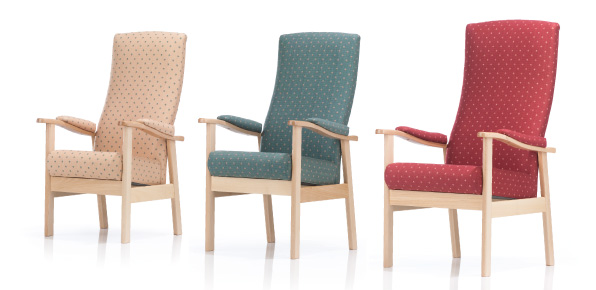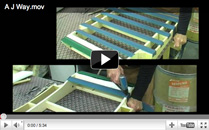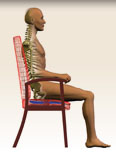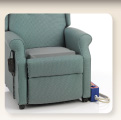A.J.Way & Co. Ltd
Unit 2 Sunters End, Hillbottom Road,
Sands,
High Wycombe,
Bucks HP12 4HS
Tel: 01494 471821
Fax: 01494 450597
Email: [email protected]
When specifying any chair, a risk assessment should be carried out to ensure it will be safe and appropriate for the user of the chair and for all who may be in the vicinity of the chair.
Identify reasons for wanting a specialist or bespoke chair or chairs, such as improved support and comfort, ease of getting in and out, a need to elevate ankles when sitting, a need to side transfer or to alleviate any specific postural or healthcare problems.
Consider how much time will be spent in the chair and what activities carried out, for example, television watching, reading, sewing, painting, dozing. Customers should try any potentially suitable chairs for as long as possible.
Long-term needs should be considered. It could be that a riser recliner is a more practical long-term solution than a high seat chair.
Features and benefits of chair sizing and accessories should be considered with an emphasis on the importance of the chair fitting the user/users as closely as possible. In a group setting a choice of chair sizes is most important to cater for different shapes, sizes and requirements.
Environmental factors should be assessed and any potential risks or hazards should be identified and taken into consideration to ensure that a safe solution is reached.
Pressure care, moving and handling and continence/infection control issues should also be considered and addressed.
High seat, high back chairs tend to have higher seats and backs and less seat depth than most general domestic seating. The chair should fit end user size as closely as possible to be comfortable, supportive and easy to rise from. Relatively firm, high density foam will provide long-term comfort and support and should result in good pressure distribution of user body weight if correctly assessed. Good wooden handgrips which extend well forward will greatly assist rising.
Manual riser chairs provide some assistance when rising. The seat lift can be left locked down or used as required. The client should always be able to lock the seat when it is in the down position to avoid being pitched out if they lean forward to pick something up. Good levels of mental alertness are required to use the product safely and this type of chair should not be used in a general seating area.
Electric riser recliner chairs provide a powered lift and recline facility together with legrest elevation. For a detailed explanation of the different types of riser recliner action please click the link below:
Basics of a Good Seating Assessment:
Seat Height is the floor to top of seat cushion measurement - aim for a knee to hip angle of 90 degrees. The higher the seat the easier it is to get out of but seat height should be in proportion to lower leg length. With the client’s feet positioned flat on the floor in the type of footwear normally worn when relaxing, there should be a right angle bend at the knees to allow the upper leg to lie flat on the seat cushion. Too high or too low a seat can cause the sitter to experience severe pressure problems and discomfort and the cushion itself may become ‘saddle shaped’. Correct seat height should assist rising, but it is important to check that the sitter can rise when the correct seat height has been assessed. If they cannot get up easily then a manual or electric riser chair may need to be considered. User weight and varying densities and hardness of seat foam in each model may affect compressed seat height.
Seat Depth is the measurement from the front of the seat cushion to the backrest of the chair. When sitting right back against the lumbar support, the seat cushion should be deep enough to support the entire length of the upper leg to the back of the knee without the cushion putting pressure on the back of the calf. The aim is to eliminate the use of pillows or cushions. If the seat is too deep the person will slide forward, losing posture and increasing localised pressure. If it is not deep enough, pressure will be concentrated on a smaller area of the body and not as well distributed. On riser recliner chairs legrest length is a very important part of seat depth measurement. Generally heels should just roll over the edge of the legrest pad.
Seat Width is the internal width of seat between the armrests. A ¾”/20mm gap either side of the buttocks should ensure arms sit comfortably on armrests and that the chair is neither too wide nor too narrow. If too wide it can be difficult to hold good posture, if too narrow the person may not be able to sit right back in the chair.
Back Height is the measurement from the back top edge of the seat cushion to the top of the backrest. The backrest should be high enough to support the back of the head whilst sitting right back in the chair. On riser recliners this is particularly important as the head will hang over the top of the backrest if the back is too low, causing the client to slide forward and adopt poor posture.
Back Shape & Angle - ideally the shape of the backrest should follow user profile as closely as possible and provide good lumbar and neck support. Some clients need or prefer a very upright chair whilst others prefer a more reclined position.
Arm Height is the measurement from the top of the seat cushion to the top of the armrest. Ideally the arms should rest gently and naturally on the armrests with the shoulder girdle in a neutral position. Chair arms that are too high will cause neck & shoulder pain and too low will cause dragging on the shoulders and make getting in and out of the chair more difficult.
Wood Finish - A.J.Way chairs are manufactured mostly from prime quality beech from sustainable sources. If the chair has a show-wood frame or wooden handgrips there is a choice of natural beech, teak, walnut or mahogany finish (see shade boards). The Shetland Drop Arm Chair, Dashwood & Staverton are, however, only available in natural beech finish.
Upholstery Fabrics & Care Instructions
A.J.Way chairs may be upholstered in a wide range of attractive soft covers, water resistant anti-microbial fabrics such as Panvelle Stretch, vinyls including Vyflex stretch vinyl or leather. Fabrics with good two-way stretch properties aid pressure redistribution and are generally more comfortable to sit on. All fabrics will deteriorate in strong sunlight & should not be placed close to direct heat sources. Please note that leather and some vinyls may be slippery and can cause the sitter to slide forward in the chair. Leathers and vinyls may also be prone to creaking on action chairs. Any stains on leather should be cleaned using proprietary leather cleaners following exact care instructions. Pile fabrics such as velvets and chenilles are prone to creasing, shading & pile crushing. This does not constitute a fabric fault and is not detrimental to the long-term wear of the material. Pile crushing and pressure marking will be exacerbated if the chair is not the correct height for the individual. Fabric should be kept clean and brushed regularly with a soft brush or the vacuum cleaner upholstery attachment. Care should be taken to remove all stains as quickly as possible with a damp cloth or proprietary cleaner following care instructions. Fabric treatments may have a detrimental effect on some fabrics. The client’s own choice of cover may be used provided a fire certificate from the manufacturer is supplied stating that it complies with the Furniture & Furnishings’ Fire Safety Regulations. Pattern repeat information is required if it has a large pattern which needs matching. Please contact the A.J.Way sales office for further fabric care details.
Riser Recliner Actions & Electrics
All moving parts must be kept dust free and lubricated from time to time with a silicone based spray to ensure smoothness of operation. There are no user serviceable parts.
Children must NEVER be allowed to play with or left unsupervised near lifting seat or reclining back chairs at any time. Clients should be advised to remove the plug from the socket whenever possible if the product is not in use. All purchasers should be made aware of the important safety instructions supplied with the chairs.
All cables should also be checked on a regular basis for any sign of wear and replaced whenever necessary. There are no user serviceable parts on our lift and recline chairs and the electrical parts should not be opened up or tampered with in any way. Extreme care should be taken to ensure that electrical cables are regularly checked and that all electrical parts are kept dry.
Warranty Information
A.J.Way Riser Recliner chairs have a two year warranty on parts subject to fair wear and tear. All other chairs have a one year warranty subject to fair wear and tear.
NB: Warranty will be invalidated if a chair is modified in any way after delivery.




